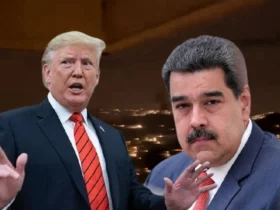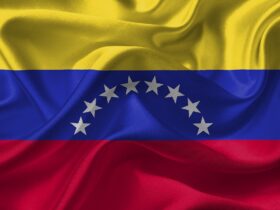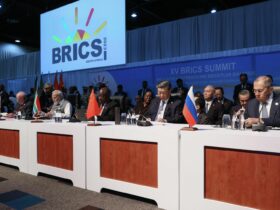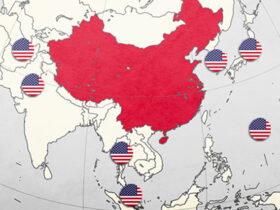US President Donald Trump recently announced his visit to India. The Indian authorities intend to welcome their guest at the highest levels in demonstration of the strong friendship between the two countries, as well as the personal friendship between Trump and Indian Prime Minister Narendra Modi.
In India, Trump is a very popular figure. As a rule, his fans are radical Hindus who love Trump for his Islamophobic positions– some even consider him a deity. On the eve of his visit, the media is full of interesting, but rather inconsequential details about the visit. Garbage collection near the Taj Mahal, an offering to Trump’s idol, the construction of a wall in Gujarat to hide the squalor of the Indian slums and Trump’s visit to the largest cricket stadium in the world are all interesting and exotic, but these concerns ultimately hide the more serious issues at place.
Indian slum dwellers are accusing the government of building a wall to "hide poor people" ahead of Trump's visit to Gujarat, @AP reports https://t.co/olcjDA5nZd (Video via @QuickTake) pic.twitter.com/vr6ik7uW3z
— Bloomberg (@business) February 19, 2020
Trade disagreement
The main issue to be discussed is whether or not a trade deal will be announced. Despite active military-political cooperation with India, after Trump came to power, the United States raised tariffs on a number of Indian goods, and New Delhi responded with symmetrical measures. Despite declarations of friendship, the United States has not abandoned its selfish policy toward India.
The United States seeks to gain access to the Indian market primarily for the poultry, meat and dairy industries, as well as to abolish local data storage rules, which, according to American companies, will increase the cost of doing business.
Modi hopes to reinstate preferences that were in place for India as a developing country until 2019 and expand access to US markets for its pharmaceutical and agricultural products.
However, according to experts, a real breakthrough in trade relations should not be expected. The maximum that leaders might agree on is a reduction in tariffs for some products, primarily Harley-Davidson motorcycles. However, the American company’s market in India is extremely small to begin with. In the first 9 months of fiscal year 2020, only 2,000 such motorcycles were sold in India, which represents 0.01% of global market sales.
The Kashmir issue
Trump has suggested that he is prepared to mediate between Pakistan and India on the Kashmir issue. The Prime Minister of Pakistan, Imran Khan, has stated approval for the idea of the American leader performing mediation functions. Recall that just last year, India and Pakistan exchanged artillery and missile strikes, coming close to all out war. The two nuclear powers of South Asia are still at daggers drawn over their mutual claims to Kashmir.
The situation in the region escalated after the Indian authorities introduced new constitutional amendments last year. The state of Jammu and Kashmir was divided into two allied territories – Jammu and Kashmir and Ladakh. This decision was preceded by a significant buildup of military power in the state, the introduction of curfews, the cessation of access to the internet and mobile communications throughout the state, as well as the arrests of local political leaders.
Nevertheless, there are serious doubts that Trump will be able to offer a model for solving the Kashmir issue in a way that would suit both sides.
From a geostrategic point of view, the main goal of the United States is to contain China. China is actively cooperating with Pakistan in the framework of the “One belt, One Road” project. The so-called CPEC (China-Pakistan Economic Corridor) is supposed to connect China (Xinjiang) and Pakistan via access to the port of Gwadar, however, for this, the transport infrastructure from Xinjiang to Pakistan must pass through the territory of Gilgit-Baltistan, the northern part of Kashmir controlled by Pakistan, which India considers part of its territory.
From a strategic point of view, the United States is not interested in peace in Kashmir, but in further exacerbating the situation, up to the point of exploiting regional hostility and terrorism in Gilgit-Baltistan in order to stop the Chinese project.
On the other hand, China is interested in stabilizing the situation in Kashmir. Theoretically, Chinese influence can be balanced by Indian influence, but only if the region becomes a hub, not only for the BRI latitudinal project, but also for the meridional corridor that will connect India, the countries of Central Asia and Russia. This initiative requires intensive cooperation in the framework of the Shanghai Cooperation Organization rather than further American intervention.
S-400 missile systems: the prospect of sanctions
It is expected that during Trump’s visit to India, defense contracts worth $5 billion will be concluded, including the supply of the MH-60R naval multirole helicopters. The US is actively developing military-technical cooperation with India on a variety of fronts. In terms of arms sales, the Americans have already overtaken the traditional arms supplier to India – Russia.
However, the United States has repeatedly threatened India with sanctions for its intention to acquire Russian S-400 anti-aircraft missile systems. According to a senior State Department official “there’s a risk of application of sanctions.”
India does not intend to abandon military-technical cooperation with Russia. As is well known, Turkey recently found itself in a similar situation, which makes things even more difficult for Washington. Any concession to New Delhi will, oddly enough, strengthen Ankara’s position. After all, why should India be allowed to buy the Russian systems while Turkey is prohibited?
Afghanistan: a new headache for New Delhi
In 2017, Trump said that the US expects India “to help us more with Afghanistan”; in 2020, he criticized Indian leadership for insufficient efforts to restore the country. Trump’s statements were condemned by both the ruling BJP party and the opposition. India is actively investing in economic projects in Afghanistan (in the past few years it has spent $ 3 billion on these goals, even constructing a new building for parliament). In other words, New Delhi is attempting to contain growing Chinese influence in its neighboring country.
During a visit to India in January, Afghanistan’s National Security Advisor Hamdullah Mohib reportedly discussed “deploying Indian troops in Afghanistan in a peacekeeping role.”
The future of Afghanistan will undoubtedly be discussed by Trump and Modi. The parameters of the deal with the Taliban, which are now being discussed by representatives of the Taliban and the US, suggest, if not a complete withdrawal, at least a reduction in American troops. The United States in principle seeks to shift responsibility to its allies– however, the ability and desire of India to become such an ally and take a more hands on role in Afghanistan is still in question. In any case, the fact that historically India was against negotiations with the Taliban could significantly worsen its position after the signing of an agreement between the United States and the Islamists.
India as an intermediary between the US and Iran
Iran-India cooperation is also in doubt due to the US’ aggressive actions. India is interested in buying Iranian oil, while Iran is dependent on India for products like tea and rice. On the one hand, India has found a way to circumvent US sanctions: for some transactions, there is direct even trade between the rupee and the rial. On the other hand, the sanctions undoubtedly hurt the Indian economy.
At the same time, the United States does make exceptions for India in terms of sanctions. US sanctions, for instance, do not extend to the Iranian Chabahar port, which India sees as a counterweight to neighboring Pakistani Gwadar, where China’s influence is growing.
India receives 65% of its oil from the Persian Gulf countries, which makes it extremely vulnerable to the US-Iranian confrontation and the prospects of blocking oil supplies along the Strait of Hormuz. Any exacerbation in tensions leads to higher oil prices which negatively affects the Indian economy.
After the assassination of Qassem Soleimani, the Iranian ambassador to India Ali Chegeni declared that Iran “welcome all initiatives from all countries, especially India as a good friend for us, to not allow escalation.”
It is to be expected that, at least behind closed doors, Indian leadership will offer the United States mediation services to normalize its dealings with Iran. Theoretically, a change of power in Oman, which had previously played the role of negotiator, gives India good chances to improve its own status in this regard. However, the Iranian leadership has demonstrated that after the assassinatio, the government is not ready to negotiate with the United States. The upcoming Iranian parliamentary elections, where anti-American conservatives are likely to win, have also cast doubts on the prospects of such mediation.
In general, despite serious rapprochement between India and the United States as a result of New Delhi’s desire to counterbalance the growing influence of Beijing, Washington has very little to offer. In general, India’s leadership is oriented toward multipolarity, and the United States cannot offer anything that would force them to turn off that path.
Despite the joyful faces of the millions of people who will meet Trump, his visit is unlikely to positively affect Modi’s position. Starting at the end of last year, mass protests of Muslims over discriminatory citizenship initiatives have swept the country. On February 8, the ruling BJP suffered a crushing defeat in the New Delhi legislative assembly.
It would be strange to assume that the US president, who has just given the go-ahead for the further occupation of Palestine, would be positively greeted by Indian Muslims. His visit will only strengthen the differences between the religious communities of the country, and such internal division will ultimately weaken the country’s position on the world stage.

















Leave a Reply